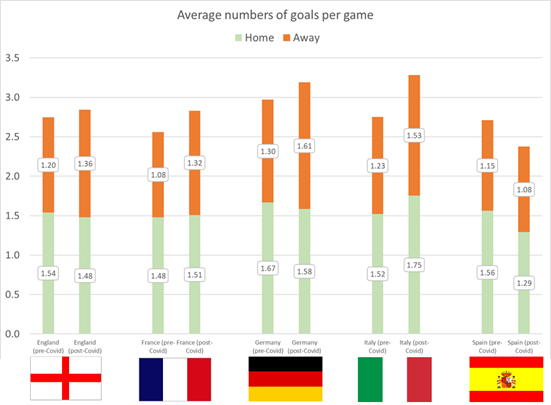Covid-19 and VAR decimate ‘home advantage’ in football leagues across Europe
Media centre
8 December 2020
As spectators returned to Premier League grounds this weekend, new research highlights that a perfect storm of Covid-19 restrictions and the introduction of VAR has had a dramatic impact on home advantage in football leagues across Europe.
LCP’s Football Analytics team who have developed TransferLab, an online football data scouting tool, have analysed results of football games across the big five European Leagues (the English Premier League, French Ligue 1, Germany’s Bundesliga, Italy’s Serie A and Spain’s La Liga), looking back over the past 6 seasons for comparative data.
The data shows that, while the introduction of the Video Assistant Referee (VAR) between 2017 and 2019 (depending on the league) reduced home advantage across Europe by around 14%, the remaining home advantage largely disappeared after there were no fans in the stadium following the pandemic. The average home advantage went down from 0.48 to just 0.10 points per game.
The key difference is that away teams have been scoring more goals when the ground is empty (average up from 1.19 to 1.38 goals per game), whereas home teams continue to score at broadly the same rate (1.55 down marginally to 1.52 goals per game).
| Pre-Covid break | Post-Covid break |
Change | |
| Number of games | 8,642 | 898 | |
| Average home points advantage per game | 0.48 | 0.10 | -0.38 |
| Average home goals per game | 1.55 | 1.52 | -0.03 |
| Average away goals per game | 1.19 | 1.38 | 0.19 |
| Average total goals per game | 2.74 | 2.90 | 0.16 |
According to LCP, the fall off in home advantage due to empty stadiums was substantial once the 2019/20 season restarted, and has become even more established in the current season where, to all intents, it has disappeared on average across the 5 leagues.
The analysis, published in “What a Difference a Crowd Makes,” highlights that:
- The figures suggest that ‘away’ teams have been playing more adventurously and scoring more goals, while home sides are still scoring at pretty much the same rate as they did pre-Covid
- While the overall effect has been remarkably similar across all five leagues, there have been some interesting regional variations.
- In the German Bundesliga, away teams adapted very quickly to empty stadiums and dominated the final part of the 2019/20 season, whereas in England there was almost no impact on results until the current season – but we’re now seeing significantly more away wins.
- Post-Covid, Italy’s Serie A has seen a surge of goals and is now the highest scoring of the big five leagues, while at the same time in Spain La Liga has seen a slump in goalscoring.
Bart Huby, Head of Football Analytics at LCP, commented: “Empty stadia have been an interesting, albeit very unwelcome, experiment providing lots of uniquely informative data. We’ll be monitoring closely what happens as crowds start to return. With areas in different Covid tiers having different rules on spectator levels, will changes in home advantage and goalscoring patterns persist into the era of restricted and then full crowd sizes?
“It’s clear that while the introduction of VAR technology led to a small reduction in home advantage, potentially because referees may be swayed by crowd reactions to unconsciously favour the home side, it is nothing compared to the impact of stadium attendance. It proves true the old adage that football fans are the 12th man.”
Ashley Mould, lead consultant in the LCP Football Analytics team, added “While there has been a clear trend across Europe in this sharp dip in home advantage, it has been fascinating to see the patterns across each of the European leagues and how they differ. In Italy, traditionally renowned for its stubborn catenaccio defences, empty stadia have resulted in an explosion of goalscoring - perhaps this is because, without crowd pressure, Italian sides have been freed up to play a more expansive game.
“In contrast, post-Covid Spain has seen a slump in goalscoring, with La Liga now by some distance the lowest scoring of these leagues. Maybe this is an extension of the Atletico Madrid effect – they’ve shown in recent years that strong defence can be the best way of competing with Real Madrid and Barcelona – and without crowds to express their dissatisfaction with defensive play, Spanish clubs may feel more comfortable playing this way.”

